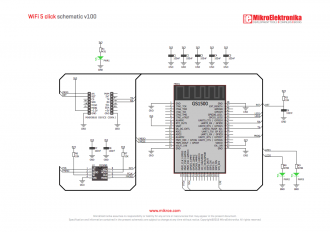
We strongly encourage users to use Package manager for sharing their code on Libstock website, because it boosts your efficiency and leaves the end user with no room for error. [more info]

Rating:
Author: MIKROE
Last Updated: 2016-05-19
Package Version: 1.0.0.0
Example: 1.0.0.0
Category: WIFI
Downloaded: 796 times
Not followed.
License: MIT license
WiFi 5 click™ is a mikroBUS™ add-on board with Gainspan’s GS1500M ultra low-power Wi-Fi module with a PCB trace antenna (external IPX antenna connector also available). WiFi 5 click communicates with the target MCU through the mikroBUS™ UART interface (TX, RX)..
Do you want to subscribe in order to receive notifications regarding "WiFi 5 Click" changes.
Do you want to unsubscribe in order to stop receiving notifications regarding "WiFi 5 Click" changes.
Do you want to report abuse regarding "WiFi 5 Click".
| DOWNLOAD LINK | RELATED COMPILER | CONTAINS |
|---|---|---|
| 1463670042_wifi_5_click_mikroc_ft90x.zip [332.40KB] | mikroC PRO for FT90x |
|
| 1463670081_wifi_5_click_mikroc_arm.zip [400.10KB] | mikroC PRO for ARM |
|
WiFi 5 click™ is a mikroBUS™ add-on board with Gainspan’s GS1500M ultra low-power Wi-Fi module with a PCB trace antenna (external IPX antenna connector also available). GS1500M supports Wi-Fi PHY speeds of up to 72.2mbps. The module is fully compliant with both IEEE 802.11b/g/n as well as with the requirements of the Wi-Fi alliance. Security features include support for WEP/WPA/WPA2, Adhoc and WPS (Wi-Fi protected setup). On the hardware side, the GS1500M module comprises two ARM7 44MHz chips (one for the radio, the other for applications), as well as on-chip Flash and SRAM. WiFi 5 click communicates with the target MCU through the mikroBUS™ UART interface (TX, RX), with additional functionality provided by RST and Prog pins (the latter in place of default mikroBUS™ AN pin).

